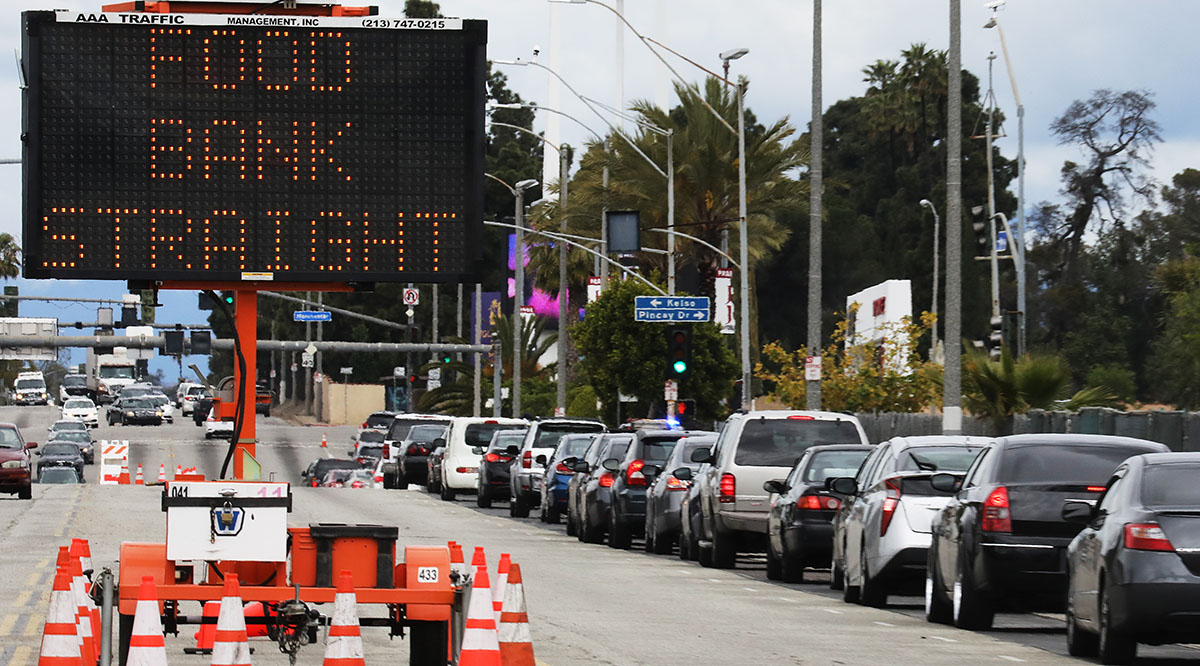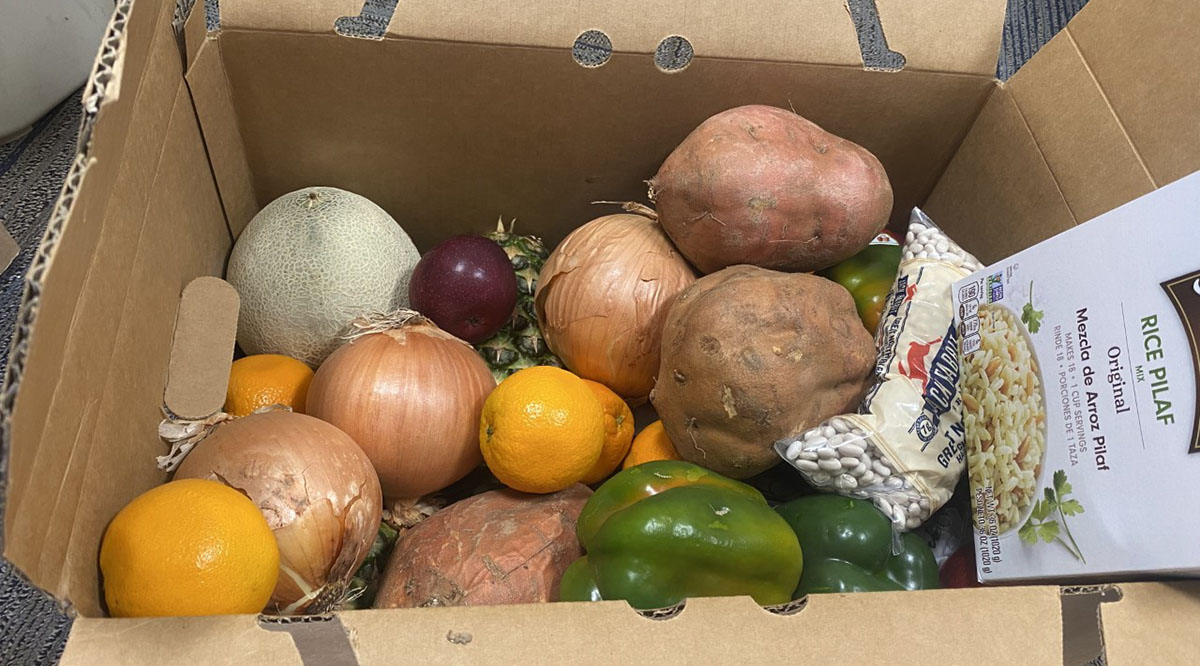
When the Massachusetts General Hospital (MGH) Revere HealthCare Center opened its therapeutic food pantry in January 2020, the plan was to start off with a three-month, 10-patient pilot program. The pantry would provide plenty of plant-based, healthy food to the patients, all of whom had nutrition-dependent chronic diseases, like diabetes and obesity, and were food insecure, meaning they lacked enough food to live a healthy and active life.
“Of course, then COVID hit,” says Jacob Mirsky, MD, a primary care physician at MGH Revere and the food pantry’s medical director.
The number of community members in the Boston area struggling to access nutritious food jumped in March as the measures put in place to contain the novel coronavirus pandemic hit them economically. Mirsky and his team decided to rehaul the entire operation and expand service to every patient treated at the center and their families.
With funding from MGH Revere and partnerships with local food nonprofits, the pantry grew from operating out of a closet to filling a 1,000-square-foot storage space and feeding up to 80 patients and their families each week.
Food insecurity across the country has risen significantly since the pandemic sidelined 14 million workers in the United States from February to May, according to the Pew Research Center.
Feeding America, the largest hunger-relief organization in the United States, estimates that 17 million people in the country could become food insecure because of the pandemic, bringing the total to more than 54 million people in the country, including 18 million children. Before COVID-19, food insecurity was at its lowest since the Great Recession, but it still impacted 37 million people.
Since food insecurity and poor nutrition are associated with several chronic illnesses that put people at higher risk for the more severe complications of COVID-19, the food access crisis threatens to exacerbate the already glaring disparities in health outcomes for vulnerable people, including low-income people, children, older adults, and immigrants living in the United States illegally.

“Though the factors underlying racial and ethnic disparities in Covid-19 in the United States are multifaceted and complex, long-standing disparities in nutrition and obesity play a crucial role in the health inequities unfolding during the pandemic,” writes a cohort of physicians and researchers in an article published in the New England Journal of Medicine in September. “A healthy diet, rich in fruits and vegetables and low in sugar and calorie-dense processed foods, is essential to health. The ability to eat a healthy diet is largely determined by one’s access to affordable, healthy foods — a consequence of the conditions and environment in which one lives.”
Mirsky believes that it is incumbent upon the health care system, and particularly academic medical centers, to take on a greater role in educating and connecting patients to healthy and tasty foods — and consequently reduce the prevalence of nutrition-related illnesses.
“We’re now living in a world where it is abundantly clear that the power of doctors and medical students and trainees expands beyond the walls of a health care setting,” Mirsky says. “Building these types of solutions [that address social determinants of health] is just as important — if not more important — than prescribing them medicine.”
Food is medicine
Over the past decade, a growing body of research has linked poor nutrition to poor health outcomes, particularly in patients with chronic diseases such as heart disease and diabetes. This can stem from not only a lack of food but also an excess of unhealthy food that can cause obesity and contribute to other health problems. For many, this could be because they live in a food desert, where there are no grocery stores within a mile of their home, or because unhealthy food may be cheaper and easier to access.
The research has birthed a movement known as “Food is Medicine,” where physicians, nutrition experts, and policymakers encourage the use of programs that provide medically-tailored food to prevent and treat serious illnesses in patients, as opposed to relying solely on pharmaceuticals and other health care interventions.
“Food is really critically important for many of the diseases that are plaguing our country and the world,” Mirsky says.
A report published by the United States Department of Agriculture in 2017 found that food insecurity was associated with 10 of the costliest and most deadly preventable diseases in the country, including hypertension, diabetes, cancer, and stroke.
Conversely, a healthier diet, particularly one that focuses on plant-based meals, has been associated with reduced risk for several chronic diseases, depression, and decreased mental function.
Barriers to access
But for millions of people in the United States, eating enough nutritious food is far easier said than done. Certain groups living in the United States face additional barriers and risks when it comes to nutrition and health, particularly in the midst of the COVID-19 pandemic.
Children: Nearly 30 million children in the United States qualified for free or reduced-cost lunches at school in 2019. The COVID-19 pandemic has complicated food insecurity among children, as the estimated number of food-insecure kids could jump from 11 million to an estimated 18 million, according to Feeding America. While many schools have continued to provide meals to children in need and food banks and pantries have amped up services, the disruption could have concerning long-term consequences. Studies have linked food insecurity in children to poor health, stunted development, behavioral issues, and difficulty keeping up in school, according to Feeding America.
Older adults: Seniors, generally defined as people age 65 and older, are at increased risk of the more severe complications that come with COVID-19. Consequently, those who live on low and fixed incomes face greater barriers to accessing adequate nutrition. This can, in turn, further increase their vulnerability to poor health outcomes.
“A lot of older adults, unfortunately, don’t have a generous retirement income,” explains David Buys, PhD, MSPH, an associate professor at Mississippi State University Extension and College of Agriculture and Life Sciences who has studied food insecurity in older adults. “They might be living on nothing but Social Security. Some might not have Social Security. We know that we have an increasing number of grandparents raising grandchildren … that can be a challenge.”
Buys says that older adults who are frail or lack transportation may struggle to get to the grocery store or to a food pantry — and that some are afraid to go out and risk exposing themselves to infection.
Food banks, food pantries, and other community outreach organizations have had to be creative in ways that they serve older adults since the pandemic hit, such as delivering food to their homes, drawing on long-standing programs like Meals on Wheels, Buys says.
One study from before the pandemic found that, in a group of older adults discharged from the hospital, those seniors that received meals delivered by Meals on Wheels had lower rates of hospital readmission in three and six months than expected.
Providing healthy meals can be a key to keeping older adults healthy and out of the hospital or congregate health care situations that might increase their risk of contracting COVID-19. It’s an issue of particular concern since more than 84% of people over the age of 65 have at least one chronic condition and many face economic hardship as a result of medical debt, according to the National Council on Aging.
Immigrants in the United States illegally: While Latino communities in the United States in general have been disproportionately impacted by the pandemic, immigrants in the country without legal permission — many of whom are Latino — are particularly vulnerable to food insecurity because they are not eligible for many government relief programs. Even before the pandemic, 1 in 4 experienced food insecurity, according to a 2016 report by Bread for the World, a nonprofit dedicated to ending hunger.
While Medicaid programs in some states, including California and Massachusetts, are beginning to cover the cost of programs that provide food to patients, people living in the country illegally are not eligible for Medicaid. Nor are they eligible for the Supplemental Nutrition Assistance Program, formerly known as food stamps, nor the $1,200 stimulus check that the federal government approved earlier this year.
“We see a movement right now to integrate more food and nutrition services into health care delivery and financing,” explains Sarah Downer, JD, associate director of whole person care at the Center for Health Law and Policy Innovation of Harvard Law School. “But every gap that we have is a place where undocumented immigrants fall into that gap.”
Instead, many rely on local food pantries for aid, which were stretched thin early in the pandemic while trying to accommodate millions of new clients, says David Velasquez, a fourth-year medical student at Harvard Medical School who is also pursuing a master of business administration at Harvard Business School and a master in public policy at Harvard Kennedy School.
“Food is a basic human need. And it’s something that we all deserve.”
David Velasquez
Fourth-year medical student at Harvard Medical School
Velasquez, who experienced food insecurity himself as the child of Nicaraguan parents who originally came to the United States illegally before being granted asylum, decided during the early months of the pandemic to research policies that could support food access for immigrants during this crisis.
He teamed up with another Harvard medical student, Jordan Kondo, and two attorneys from the Center for Health Law and Policy Innovation, Downer and Emily Broad Lieb, JD, to write a journal article that argued for policies that could help bring relief to immigrants who aren’t eligible for much government aid.
For example, they said the government should make it a priority to fund emergency food services programs that are accessible to those living in the country illegally, such as food banks and community health centers, and that health systems should ensure that they are not excluded from programs that integrate nutrition into health care delivery.
“Food is a basic human need,” Velasquez says. “And it’s something that we all deserve.”
Facing a long-term problem
When Mirsky was crafting the model for MGH Revere’s therapeutic food pantry, it was important to him that the pantry provide not only nutritious food but also the means to enjoy it.
Patients who visited the pantry initially received pots and pans, a spatula, oil, spices, and consultations with a nutritionist who could help them come up with recipes that they enjoy. The goal is to foster self-motivated healthy lifestyles. When the pantry expanded to a greater number of patients due to the pandemic, they could no longer offer all these services, but they hope to reintroduce them in the future.
“Food and eating are an essential part of the human experience,” Mirsky says. “Cooking and enjoying healthy food is a very powerful and respectful way of improving someone’s life.”
The MGH Revere pantry in the Boston area is just one of many nutrition outreach programs that health care providers across the country have increasingly implemented in recent years, as the American Hospital Association highlights in its social determinants of health report series. More health care providers are screening for food insecurity regularly and helping connect their patients to resources.
Still, food insecurity persisted before the pandemic, and the pandemic has further stretched existing community resources, as NPR reported in September.
Mirsky notes that the pantry at MGH Revere is already feeling the strain and is leading an effort to raise funds for a permanent location for the pantry. He’s also concerned about how much food they will be able to acquire in the winter, when there will be less local produce available and as renewed COVID-19 surges threaten to further stress systems.
“Our goal is to recognize that this is a very long-term problem that is going to require a long-term solution.”
